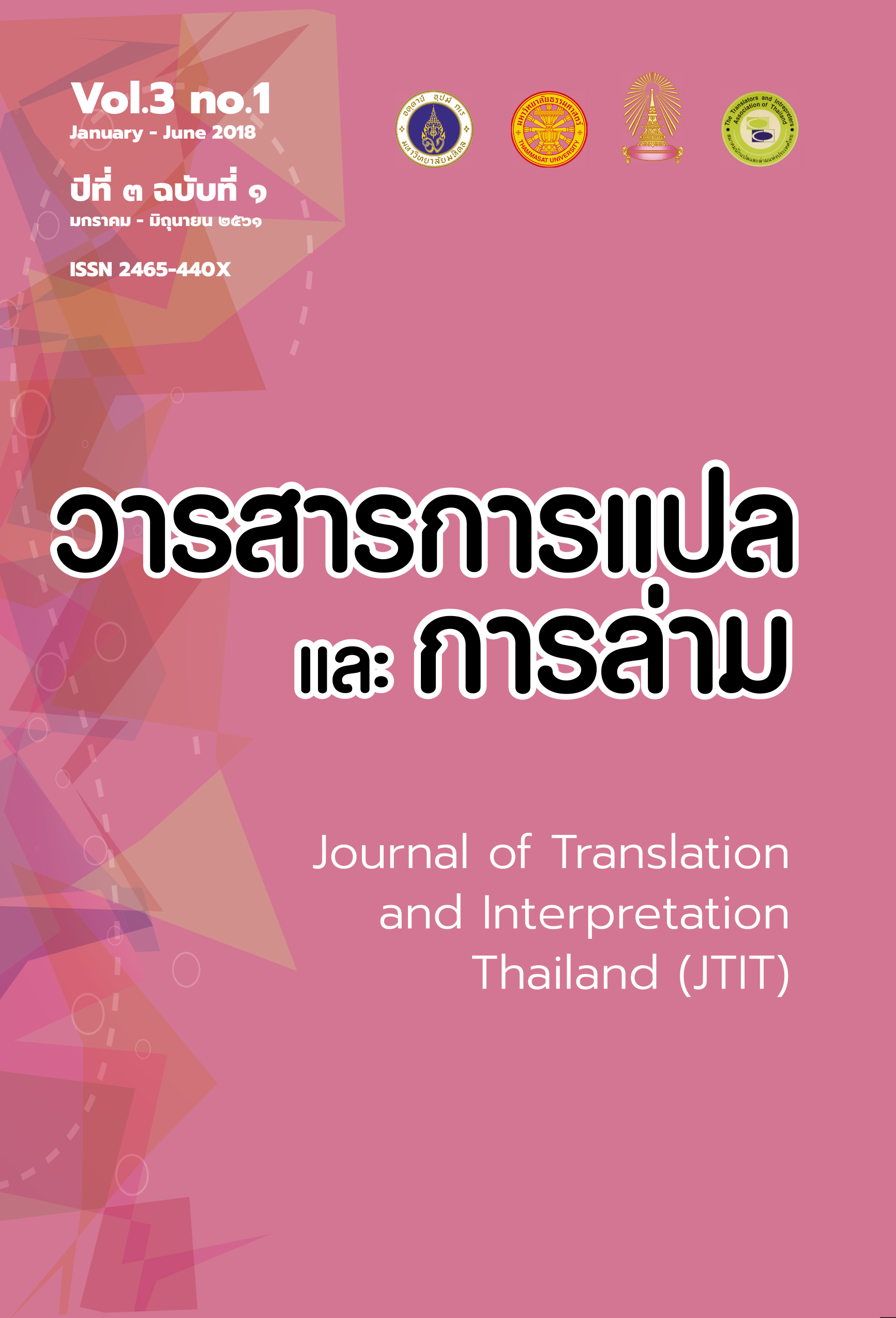การศึกษาเปรียบเทียบความเป็นเควียร์ในบทแปลนวนิยาย เรื่อง The Picture of Dorian Gray ของออสการ์ ไวลด์ จากสำนวนการแปลของ อ.สนิทวงศ์ และกิตติวรรณ ซิมตระการ
Main Article Content
บทคัดย่อ
งานวิจัยฉบับนี้มีวัตถุประสงค์เพื่อศึกษาการแปลที่สร้างหรือนำเสนอความเป็นเควียร์จากตัวบทวรรณกรรมยุควิคตอเรียนตอนปลาย เรื่อง The Picture of Dorian Gray ของ ออสการ์ ไวลด์ (Oscar Wilde) ระหว่างสำนวนแปลของ อ.สนิทวงศ์ (พ.ศ. 2517) และ กิตติวรรณ ซิมตระการ (พ.ศ. 2552) โดยเฉพาะด้านความเสน่หาเพศเดียวกัน (Homoreotics) และการแสดงออกที่ค่อนไปทางสตรีเพศ(Effeminacy) ที่ผู้ประพันธ์ต้นฉบับสื่อความนัยไว้อย่างแนบเนียนผ่านตัวละครชายใน เรื่อง ผู้วิจัยใช้ทฤษฎีเควียร์เพื่อนิยามและค้นหาความเป็นเควียร์ที่ปรากฏทั้งในต้นฉบับและฉบับแปล และใช้แนวคิดของอ็องเดร เลอเฟอแวร์ (André Lefevere) เป็นกรอบการวิเคราะห์ปัจจัยทางสังคมและวัฒนธรรมที่มีอิทธิพลต่อทัศนคติและแนวทางของนักแปล ผู้วิจัยยังได้วิเคราะห์องค์ประกอบนอกเหนือจากเนื้อความหลักของตัวบท (Paratextual Elements) เพื่อพิจารณาปัจจัยนอกตัวบทที่เป็นตัวกำหนดกรอบการรับรู้ของผู้อ่านในเรื่องเพศที่เบี่ยงเบนจากบรรทัดฐานของสังคม ผลการวิจัยพบว่าสำนวนแปลของ อ.สนิทวงศ์ บ่งชี้และขยายอัตลักษณ์ความเป็นเควียร์ของตัวละครออกมาชัดเจนกว่าฉบับแปลของกิตติวรรณ ซิมตระการ และชัดเจนยิ่งกว่าตัวบทต้นฉบับ แต่การวิเคราะห์องค์ประกอบนอกเหนือจากเนื้อความหลักของตัวบทกลับปรากฏว่าฉบับแปลของ กิตติวรรณ ซิมตระการ มีองค์ประกอบที่บ่งชี้อย่างชัดเจนถึงประเด็นเรื่องเพศ ทั้งนี้ยังพบว่า คตินิยมของผู้แปลและขนบวรรณศิลป์ เป็นปัจจัยสำคัญที่ส่งผลต่อแนวทางการแปลทั้งสองฉบับ ส่วนผู้อุปถัมภ์มีอิทธิพลในการนำเสนอเรื่องเพศเฉพาะในสำนวนแปลของกิตติวรรณ ซิมตระการ
Article Details
เอกสารอ้างอิง
ออสการ์ไวลด์. (2517). เงาบาป (อ.สนิทวงศ์, ผู้แปล). กรุงเทพมหานคร: แพร่พิทยา.
ออสการ์ไวลด์. (2552). ภาพวาดของโดเรียน เกรย์ (กิตติวรรณ ซิมตระการ, ผู้แปล). กรุงเทพมหานคร: ฟรีฟอร์ม, 2552. Carroll, J. (2005). Aestheticism, homoeroticism, and Christian guilt in the picture of Dorian Gray. Philosophy and Literature, 29(2), 286-304. Fatal. (n.d.) In Oxford Dictionaries online. Retrieved from https://www.oxforddictionaries.com/definition/english/fatal
Genette, G. (1997). Paratexts: Thresholds of interpretation. (J. E. Lewin, Trans). Cambridge: Cambridge University Press.
Gustafsson, S. (2011). Aesthetic principles in Oscar Wilde’s the picture of Dorian Gray (Bachelor’s thesis). Halmstad: Halmstad University.
Hansen, C. (2011). Queer love: Floral discourse in Oscar Wilde’s the picture of Dorian Gray. Thousand Oaks, California: California Lutheran University.
Kaye, R. A. (2004). Gay studies/queer theory and Oscar Wilde. In F. S. Roden (Ed.), Palgrave Advances in Oscar Wilde Studies (pp. 189- 223). Hampshire: Palgrave MacMillan.
Lefevere, A. (1992). Translation, rewriting, and the manipulation of literary fame. London: Routledge.
Mazzei, C. (2007). Queering translation studies (Master’s thesis). Amherst, Massachusetts: University of Massachusetts Amherst.
Munday, J. (2012). Introducing translation studies: Theories and applications. New York: Routledge. Nagoshi, J. L., Nagoshi, C. T., & Brzuzy, S. (2014). Feminist and queer theories: The response to the social construction of gender. In Gender and Sexual Identity Transcending Feminist and Queer Theory. Springer: New York.
The General Conference Executive Committee. (2012, October 17). Official statements. Homosexuality. Retrieved June 1, 2015, from https://www.adventist.org/en/information/officialstatements/statements/article/go/0/homosexuality/
Spargo, T. (1999). Postmodern encounters: Foucault and queer theory. Cambridge: Icon Books.
Spurlin, W. J. (2014). Queering translation. In S. Bermann & C. Porter (Eds), A Companion to Translation Studies (pp. 298-309). Oxford: John Wiley & Sons Ltd.
Venuti, L. (1995). The translator’s invisibility: A history of translation. London: Routledge.
Von Flotow, L. (2007). Gender and translation. In A Companion to Translation Studies (pp. 92-105). Clevedon: Multilingual Matters.
Wilde, O. (2012). The picture of Dorian Gray. [Kindle]. Retrieved June 1, 2015, from Amazon.com
Zhang, M. (2012). Translation manipulated by ideology and poetics: A case study of the Jade Mountain. In Theory and Practice in Language Studies, 2(4), 754-758


